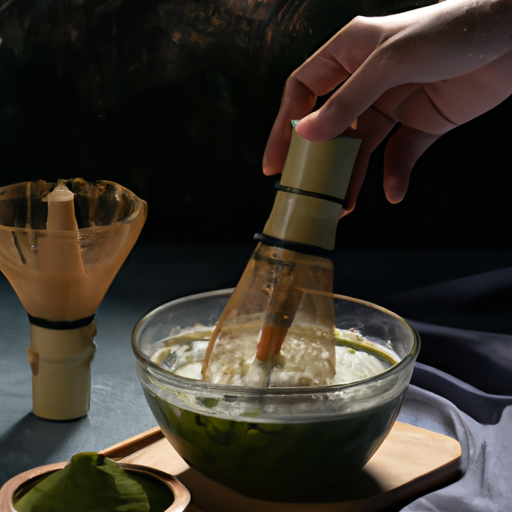Hello! I’m thrilled to be able to show you today how to prepare Lipton Matcha Green Tea. Matcha green tea, which is well-loved in Japan, is currently becoming popular all over the globe due to its health advantages and distinctive flavor.
Lipton has come up with a convenient way for us to enjoy matcha green tea at home by providing us with their own matcha green tea powder. In this article, I’ll walk you through the steps on how to make a perfectly frothy cup of Lipton Matcha Green Tea that you can enjoy any time of day.
So let’s get started!
Key Takeaways
- Proper storage of matcha green tea powder is crucial for preserving its potency and flavor.
- Using a bamboo whisk called a chasen is essential for proper whisking of matcha green tea.
- Matcha green tea is a potent source of antioxidants, vitamins, and minerals, and drinking it daily can have several health benefits.
- Lipton Matcha Green Tea is a convenient and delicious way to enjoy matcha green tea at home, and can be customized with sweeteners or added to recipes like smoothies or baked goods.
What You’ll Need to Make Lipton Matcha Green Tea
You’ll need a few simple ingredients to make Lipton Matcha Green Tea, including some boiling water and a teaspoon of the matcha powder. You can also add sweeteners like honey or sugar if you prefer your tea to be on the sweeter side.
To start brewing the tea, heat up some water in a kettle or pot until it reaches boiling point. Once the water is ready, measure out one teaspoon of Lipton Matcha Green Tea powder into a cup or bowl. If you don’t have this specific brand of matcha powder, there are other alternatives available in grocery stores or online shops. Be sure to purchase good quality matcha powder from trusted sources so that you get the best flavor and health benefits from your tea.
Next, pour the hot water over the matcha powder and whisk it well until it becomes frothy and smooth. This might take some practice but with time, you’ll be able to master this art of making delicious matcha green tea at home!
Now that we’ve measured out our ingredients and prepared our tea mixture, let’s move on to how we can steep it perfectly for maximum flavor extraction!
Measure the Matcha Green Tea Powder
Firstly, grab your handy teaspoon and scoop a dash of the powdered goodness into your cup. Don’t worry if it looks like a sprinkle of fairy dust, a little goes a long way in this modern era.
Matcha green tea powder is delicate and must be handled with care to maintain its freshness. Proper storage is essential to preserve its potency and flavor. Store it in an airtight container away from heat and moisture.
Next, mix the matcha powder with other ingredients for added flavor and nutrition. You can add honey, milk, or even fruit juice to enhance the taste and nutritional value of your matcha green tea. Mix it well until all the ingredients are evenly incorporated, ensuring that no lumps remain at the bottom of your cup.
Now that you’ve measured out the perfect amount of matcha green tea powder and mixed it with any additional ingredients desired, you’re ready for the next step: boiling water! Bring fresh water to boil then let it cool down for 2-3 minutes before pouring over your mixture in order not to damage any nutrients found in matcha as they’re sensitive to high temperatures.
Boil Water
Once the water reaches a rolling boil, it’s time to add some heat to your day and prepare for a delicious brew. Boiling water may seem like a simple task, but there are some tips to ensure that you’re doing it efficiently. First, make sure you use the right amount of water for the amount of matcha green tea powder you’ll be using. Refer to the table below for guidance.
| Matcha Green Tea Powder | Water |
|---|---|
| 1 teaspoon | 8 oz |
| 2 teaspoons | 12 oz |
| 3 teaspoons | 16 oz |
Secondly, use a kettle with a thermometer or an electric kettle with temperature control settings to monitor the water temperature. The ideal temperature for making matcha green tea is between 160°F and 180°F. If you don’t have access to these tools, bring the water just to boiling point and let it cool down for about two minutes before adding it to your matcha green tea powder.
It’s important not to use boiling hot water as this can result in bitter-tasting tea and destroy some of the beneficial nutrients in matcha green tea. Once you’ve boiled your water accurately, move on to the next step; adding hot water to your bowl or mug.
By following these tips for boiling water efficiently and understanding how important water temperature is when making matcha green tea, you’ll be well on your way towards brewing a delicious cup of this delightful beverage!
Add Hot Water to the Bowl or Mug
After boiling the water to the perfect temperature, it’s time to pour it into your favorite mug or bowl and watch as the steam rises up to greet you.
There are different ways to prepare matcha green tea but adding hot water is perhaps the simplest. One of the benefits of incorporating matcha into your daily routine is that it contains more antioxidants than regular green tea.
To make a delicious cup of Lipton Matcha Green Tea, add a teaspoon of the powder into your mug or bowl. Then, pour in about 6 ounces of hot water and stir until all lumps have dissolved. You can adjust the amount of powder and water based on your preference for taste and strength.
Whisking the powder and water together will create a frothy layer on top which enhances its flavor even further.
But before we get there, let’s first explore how you can enjoy matcha with just hot water alone.
Whisk the Powder and Water Together
Now that you’ve added hot water to your bowl or mug, it’s time to get whisking and create a frothy layer on top of your delicious matcha concoction. Whisking the powder and water together is an important step in the process as it ensures that all the powder is fully dissolved into the liquid, creating a smooth and creamy texture. It’s essential to use proper whisking techniques here, as improper techniques may result in clumps of matcha powder at the bottom of your drink.
To properly whisk your matcha green tea, use a bamboo whisk called a chasen. Hold the chasen with one hand while using the other hand to steady your bowl or mug. Start by gently stirring back and forth with quick wrist movements until the mixture becomes frothy and light green in color. Be sure to avoid overwhisking as this will cause your tea to become bitter.
If you’re looking for a unique twist on traditional matcha flavors, consider pairing it with different types of milk such as almond or coconut milk. These types of milk add their own distinct flavor profiles that complement the earthy tones of matcha perfectly. With proper whisking techniques and flavor pairings, you’ll be able to enjoy a perfect cup of Lipton Matcha Green Tea every time.
Moving onto our final section about enjoying your Lipton Matcha Green Tea, don’t forget about presentation! Adding some extra froth or garnishing with mint leaves can take it from being just another drink to something truly special.
Enjoy Your Lipton Matcha Green Tea
To savor the full flavor of this creamy and frothy beverage, take a moment to appreciate its vibrant green hue before taking a sip. Lipton matcha green tea isn’t just any ordinary drink, but rather a delicious and healthy treat that can be enjoyed in many ways.
Here are three ways to enhance the taste of your lipton matcha:
-
Add honey or agave syrup for sweetness: If you have a sweet tooth like me, then adding honey or agave syrup is an excellent way to balance out the bitterness of matcha while providing natural sweetness.
-
Mix with milk for creaminess: For those who prefer their drinks creamier, mixing lipton matcha with milk creates a smooth and velvety texture that complements the earthy flavors of matcha.
-
Top it off with whipped cream: If you’re feeling indulgent, topping off your lipton matcha with whipped cream adds a decadent touch that elevates this already delicious drink.
Drinking lipton matcha green tea daily has numerous health benefits such as boosting metabolism, increasing energy levels, and improving mental focus. So, don’t hesitate to make this delightful beverage part of your daily routine!
In the next section, we’ll delve deeper into the various health benefits of lipton matcha green tea.
Health Benefits of Lipton Matcha Green Tea
It’s no secret that this vibrant and frothy beverage packs a punch of health benefits, from boosting metabolism to improving mental focus.
But did you know that Lipton Matcha Green Tea has even more health benefits than other green teas?
Matcha is made by grinding whole green tea leaves into a fine powder, which means you’re consuming the entire leaf instead of just steeping it in hot water like traditional green tea.
This makes matcha a more potent source of antioxidants, vitamins, and minerals.
If you’re looking for delicious matcha recipes, Lipton has got you covered.
Try adding honey or agave nectar for a touch of sweetness, or mix with almond milk for a creamy latte.
You can also add matcha powder to smoothies or baked goods for an extra health boost.
The possibilities are endless!
Matcha vs other green teas: While all types of green tea have health benefits, matcha stands out as being particularly high in antioxidants called catechins.
These powerful compounds help protect your cells from damage caused by free radicals and may reduce your risk of chronic diseases like cancer and heart disease.
Plus, because you’re consuming the whole leaf in powdered form rather than just steeping it in hot water like regular green tea, you get more nutrients per cup!
In the next section about differences between Lipton Matcha Green Tea and traditional green tea, we’ll explore why matcha is not only healthier but also tastier than other types of green tea on the market today!
Differences Between Lipton Matcha Green Tea and Traditional Green Tea
I’ve always been a fan of green tea, but recently I discovered Lipton Matcha Green Tea.
What sets it apart from traditional green tea are its distinct flavor and higher nutritional value.
While both teas come from the same plant, matcha is made by grinding whole green tea leaves into a fine powder.
This process results in a richer taste and more concentrated nutrients.
Flavor
The flavor of Lipton matcha green tea is rich and earthy, with a subtle sweetness that lingers on the tongue. When I first tried it, I was impressed by how different it tasted compared to traditional green tea.
Here are some things to keep in mind when exploring the taste of Lipton matcha green tea:
-
Sweet or bitter? The flavor of matcha can be described as both sweet and bitter. It’s important to note that the bitterness comes from the natural compounds found in green tea leaves, which have many health benefits.
-
Best ways to enhance the flavor: One way to enhance the flavor of Lipton matcha green tea is by adding honey or another natural sweetener. You can also try steeping it for a shorter amount of time if you prefer a lighter taste. Finally, experimenting with different water temperatures can also affect the overall flavor.
When it comes to making Lipton matcha green tea, understanding its unique flavor profile is crucial for achieving an enjoyable drinking experience. Moving forward, let’s explore its nutritional value and health benefits.
Nutritional Value
Oh boy, now we get to delve into the nutritional goodies of this trendy green beverage. Lipton Matcha Green Tea is a great source of antioxidants that can do wonders for your body.
One cup of this tea has about 70mg of caffeine and is also rich in vitamin C, potassium, and fiber. Matcha recipes are not only tasty but also nutritious as they contain all the benefits of green tea. You can add it to smoothies or make desserts with matcha powder!
Other sources of antioxidants include dark chocolate, berries, nuts, and seeds. Incorporating these foods into your diet can help reduce inflammation in the body and boost your immune system.
Now that you know more about the health benefits of Lipton Matcha Green Tea, let’s move on to where to buy it!
Where to Buy Lipton Matcha Green Tea
Looking for a place to score some delicious Lipton Matcha Green Tea? Check out your local grocery or health food store! You may find it in the tea section with other green teas, or in the specialty section with other matcha products.
If you’re having trouble finding it, don’t hesitate to ask a store associate for assistance.
When searching for Lipton Matcha Green Tea, keep an eye out for other quality brands of matcha as well. Some of the best brands for matcha green tea include Ippodo, Aiya, and DoMatcha. These brands use high-quality leaves that are grown and processed using traditional Japanese methods.
Not only can you enjoy Lipton Matcha Green Tea as a hot beverage, but you can also use the powder in many recipes. Some popular dishes include matcha lattes, smoothie bowls, and even baked goods like cookies and cakes.
So, not only is it delicious, but it’s also versatile in the kitchen!
Frequently Asked Questions
What are the origins of matcha green tea?
Back in the day, Matcha Green Tea was a luxury only enjoyed by Japanese royalty and samurai warriors. The origins of this tea can be traced back to China during the Tang Dynasty (618-907), where it was used as a medicinal drink.
It wasn’t until Zen Buddhist monks brought the tea to Japan in the 12th century that it became more widely consumed and incorporated into traditional Japanese culture. Matcha Green Tea has since become known for its cultural significance in Japan, with ceremonial tea preparations being an important part of social gatherings and events.
Today, Matcha Green Tea is enjoyed all over the world for its unique flavor and health benefits, but its historical roots remain an important part of its legacy.
How much caffeine is in Lipton Matcha Green Tea compared to traditional green tea?
When it comes to caffeine content, Lipton Matcha Green Tea has more caffeine than traditional green tea. A single serving of Lipton Matcha Green Tea contains about 35 milligrams of caffeine per eight-ounce cup, whereas traditional green tea only has around 25 milligrams.
That being said, the health effects of drinking matcha are still very positive. Matcha is loaded with antioxidants and has been shown to improve brain function, boost metabolism, and even reduce the risk of certain types of cancer.
So while Lipton’s matcha may have a bit more kick than regular green tea, it’s still a great option for those looking to improve their overall health and wellbeing.
Are there any side effects to drinking Lipton Matcha Green Tea?
Before delving into the potential health benefits of drinking Lipton Matcha Green Tea, it’s important to address any possible side effects.
While matcha green tea is generally considered safe for most people, consuming excessive amounts may lead to negative effects such as insomnia, irritability, and an upset stomach.
Additionally, those with certain health conditions or taking certain medications should consult with a healthcare professional before incorporating matcha green tea into their diet.
However, when consumed in moderation, Lipton Matcha Green Tea can provide numerous health benefits such as improved brain function and increased metabolism compared to traditional green tea.
It’s important to keep in mind that while matcha green tea can be a healthy addition to one’s diet, it shouldn’t be relied upon as a sole solution for any health concerns.
Can Lipton Matcha Green Tea be used in recipes other than just as a beverage?
When it comes to using Lipton Matcha Green Tea in recipes, the possibilities are endless. Not only can you enjoy it as a beverage, but you can also add it to smoothies, baked goods, and even savory dishes like stir-fries or marinades.
The unique flavor of matcha adds depth and complexity to any recipe, while also providing numerous health benefits. Matcha is packed with antioxidants and has been shown to boost metabolism and enhance focus and concentration.
So why not try incorporating Lipton Matcha Green Tea into your next recipe? From matcha cookies to matcha lattes, there are plenty of delicious recipe ideas out there just waiting for you to give them a try!
How does Lipton Matcha Green Tea compare to other brands of matcha green tea on the market?
When it comes to taste comparison and health benefits, Lipton Matcha Green Tea holds its own against other brands on the market.
As someone who’s tried various matcha green teas, I can confidently say that Lipton’s version has a smooth and creamy texture with a light sweetness that isn’t overpowering.
In terms of health benefits, matcha green tea is known for its high concentration of antioxidants and amino acids, which promote overall health and wellbeing.
Compared to other brands, Lipton’s matcha green tea offers these same benefits at an affordable price point.
Overall, if you’re looking for a delicious and nutritious option in the crowded world of matcha green tea, Lipton is definitely worth considering.
Conclusion
Well, folks, we’ve reached the end of our journey on how to make Lipton Matcha Green Tea. Did you enjoy whisking that powder into a frothy goodness? Did your taste buds dance with joy as you sipped on that healthy elixir? I sure hope so!
But let’s be real here, making Matcha Green Tea isn’t exactly rocket science. In fact, it’s pretty darn easy. So easy, in fact, even a caveman could do it (if they were still around).
But don’t let the simplicity fool you – this tea packs a powerful punch when it comes to health benefits. So go ahead and indulge in some Lipton Matcha Green Tea- your body will thank you for it. And while you’re at it, why not try out some traditional green tea too?
Who knows, maybe one day we’ll all be drinking matcha lattes instead of pumpkin spice ones. Stranger things have happened!









